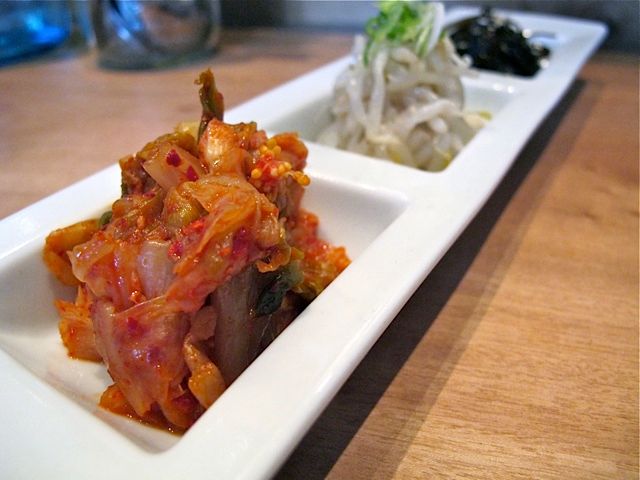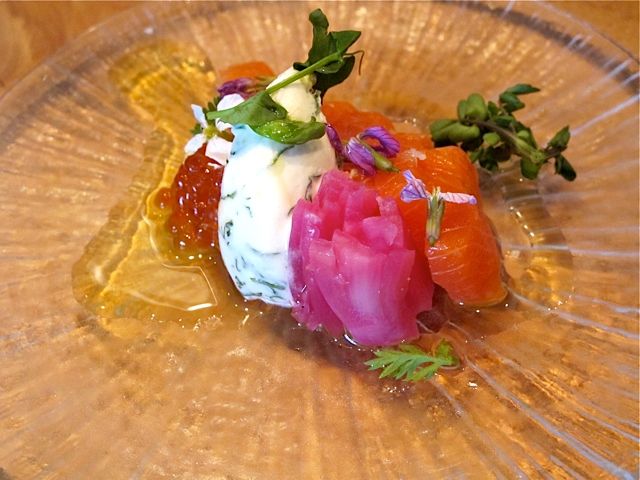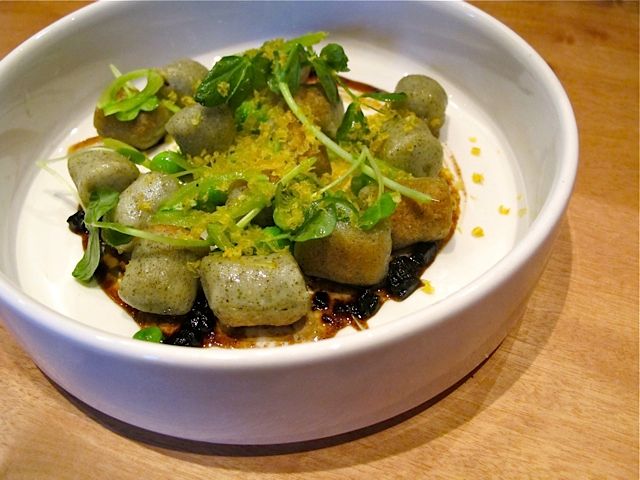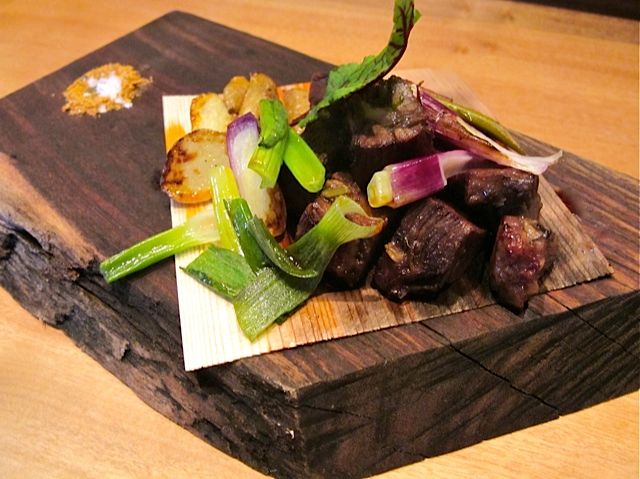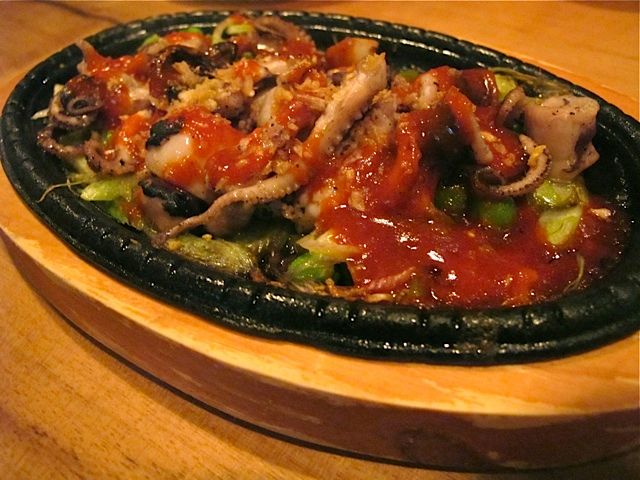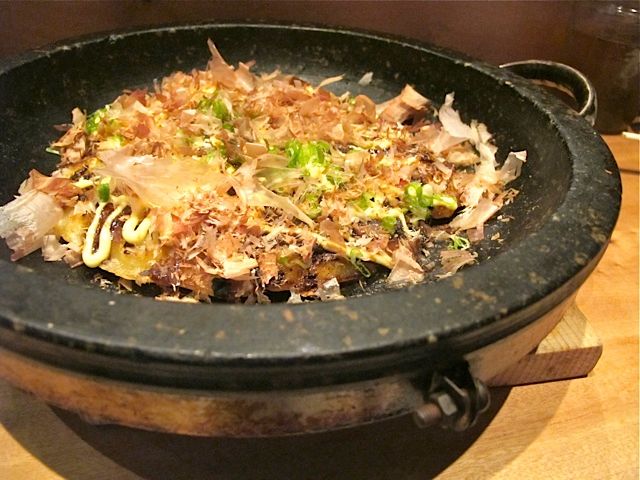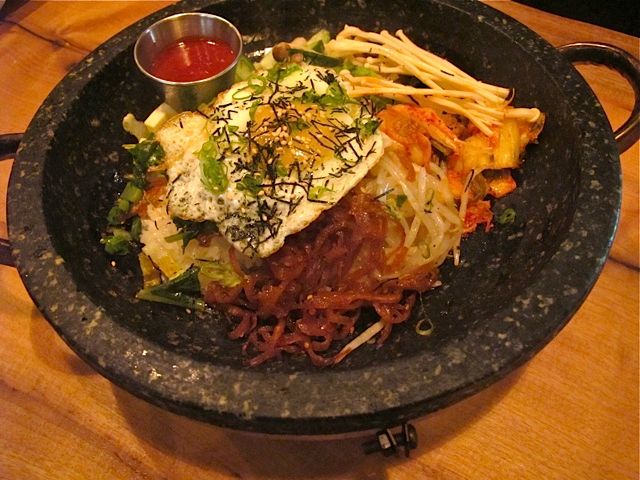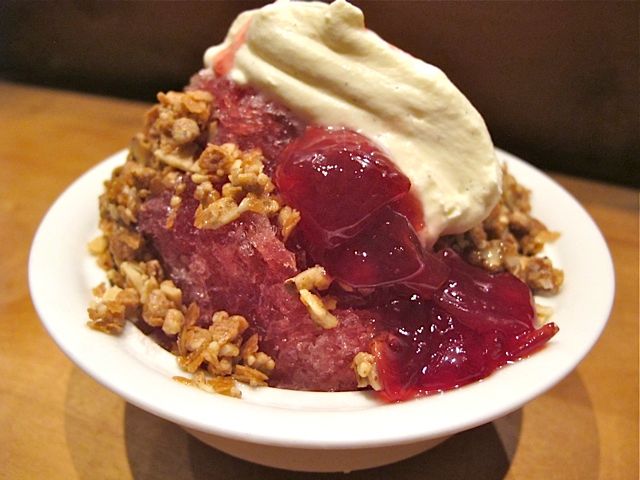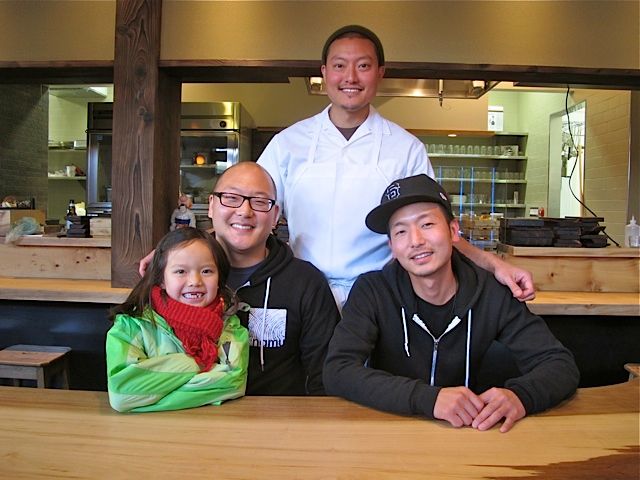The South may have the Lee Bros., but here in SF, we have our own Lee brothers—three of ‘em (Dennis, Dan, and David). I have been a dedicated fan of their own particular version of Cal-Korean (and Japanese) food and urban-yet-welcoming vibe since they opened the original Namu location out on foggy Balboa Street at 6th Avenue—I’d happily make the trek any night for their KFC (Korean fried chicken) and black cod and house-infused chile soju. But now with their latest venture, NAMU GAJI, they’re all grown up, holding it down on the corner of 18th Street and Dolores in the thick of the Mission “gourmet ghetto,” making it almost too easy for all of us to swing by and enjoy their inspired cuisine (yup, they are bizzeee).
The space is dominated by the communal table made from bay laurel wood that runs down the middle—there’s an open kitchen with seven counter seats (these will soon be reserved for guests ordering the tasting menu), tables in the back, and another row of counter seats looking out the windows onto 18th Street (and the line of people waiting for an ice cream at Bi-Rite Creamery). The space has a rustic look that’s rich with woods—you can read about the interior details here—plus thoughtful touches like gray burlap bags you can put your purse into so it doesn’t have to sit on the floor (thanks, guys).
As you nosh from a plate of banchan (kimchee, mung beans, marinated kombu), you can start diving into the menu. It will inspire you to over-order, starting with items from the raw section (all $16), like a colorful plate with slices of cured wild salmon, pretty blossoms, pickled red onion, yuzu cream with shiso, and ikura—wait until you taste the ikura with the olive oil pooling on the plate; what a pairing.
The crispy section (all $12) is where you’ll find the ridonkulous potato puffs—just imagine fried balls made of the mashed potatoes of your dreams, with a flurry of Parmesan and a gochujang (fermented chile paste) aioli that you dunk them into. Wicked. There’s also an excellent tempura with uni wrapped in shiso and seasonal vegetables (one night it was asparagus, yellow onion, and snap peas).
The plates section (all $14) has chef Dennis’ silky mushroom dumplings (a holdover from the previous Namu menu), plus the addition of buckwheat gnocchi, the plate spiked with a black garlic gastrique, shaved cured egg, and fresh peas and shoots. The brothy cabbage dish is homey and satisfying, with tender enoki mushrooms, some smokiness from the bonito shavings, and the unexpected addition of walnuts. The grilled baby octopus transported me to a late night in L.A.’s Koreatown, all sauced up and spicy from the housemade gochujang sauce, with extra flava from the spring onions and fried garlic. The mushroom plate (with royal trumpets and maitake) is more delicate, with fresh leaves of mizuna.
A unique feature to the restaurant is the charcoal grill—not many places are given clearance to cook with actual charcoal, which makes a big difference in how the food tastes as it slowly caramelizes over the binchotan. It’s a process that can’t be rushed, and I recommend sitting at the counter so you can watch. The star of the grilled section (all $20) is the beef tongue (served on a thin sheet of cedar), which entails a seven-day curing process—it’s like Korean tongue pastrami. You will order it every time, mark my words. The “pig parts” included slices of Llano Seco loin, so succulent with a miso sauce.
My favorite section is the comfort section (no surprise there; all $16). The Namu burger continues to rock, but the okonomiyaki is what hits it out of the freaking park. Who is cooking okonomiyaki in a stone pot? The Lee brothers, that’s who. It’s the mountain yam pancake of your dreams (you didn’t know you had that dream, but you will discover you did—and you won’t believe the seared texture of the pancake from the stone pot), with oysters, cabbage, their stellar kimchee….it’s the next level of the “I’m drunk and hungry” dish. The stone pot bibimbap is the other champ—just wait until you taste the browned rice (it reminded me of why I love genmaicha) with the egg and kimchee all stirred in, plus a rotating array of ingredients. Kind of like the carnitas at Nopalito, I recommend getting an order to go so you can have the best breakfast in the world the next morning. Trust.
So while I’m obviously loving this place hard like a new pet puppy, there is one issue I have: I’m not a big fan of when restaurants lump a bunch of dishes under one price point—you know, like all desserts for $8. The menu does that here for its various sections, which looks simpler, but can make the value of some of the dishes a little questionable. But there is no denying the quality of the ingredients, that’s for sure. I appreciate all the garnishes and accompaniments—there’s a lot of refinement in the plating as well (chef Dennis is working with chef de cuisine Michael Kim, previously at SPQR and Craft Los Angeles).
Since the dining room is intimate, ideally you should just come with one other person (or be prepared to wait a little longer). Our party of three had a cozy time at the edge of the communal table—the curving edges almost hug you. The food is very group-friendly as well—love that.
The kitchen sent out a few preview dishes from the upcoming tasting menu—let’s just say the onsen egg with shaved tuna heart and cured egg, chile oil, Korean chile flakes, black garlic, and the kicker of the scallop chips will rock your house. The boys have all kinds of cool culinary projects, from curing eggs to making their own black garlic to pickling up a storm—you’ll see these touches all over the menu. They also have their own farm plot in Sunol, and are having their own Korean herbs, greens, and more grown for them. Freshness is key here—you even get to grate your own fresh wasabi.
Don’t pass up the hand-cranked shaved ice from a vintage ice machine for dessert ($8)—we had housemade cherry syrup with candied cherry, almond crunch (like a salty granola), and vanilla cream. Score. Nope, no high-fructose BS here—it’s revelatory. You can also order it at the takeout window, which is open during the day (11:30am-4pm daily), or you can sit in the dining room. The takeout menu features their street food items, like Korean tacos, the stoner-approved gamja fries, and the KFC.
The brothers have always had good taste in sake, so you’ll find some choice selections on the list, along with some soju, and a special rice beer made by Magnolia. Wine director Collin Casey has worked with Natural Process Alliance winery for a proprietary Namu blend as well—it’s an orange wine, so while it’s not for everyone, it’s kombucha-esque acidity syncs with the flavor profiles here. Wine geeks will find plenty to enjoy on his list (there’s a reserve list as well).
The staff skews on the younger side, but they’re friendly and quick with answers, while the soundtrack of A Tribe Called Quest and AIR plays in the background. The brothers walk the tightrope of tradition and urban living really well, and it’s exciting to see how well their sophomore album is debuting on the charts—or should I say off the charts?
TIP: Having a tough time with parking? Don’t even want to try? You can valet your car at Locanda at 557 Valencia St. between 16th and 17th Streets. Interior photo by Mohammad Gorjestani.
